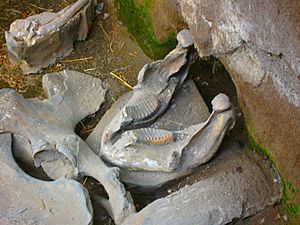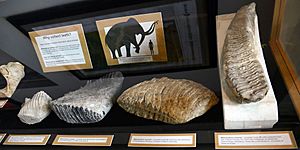Columbian mammoth facts for kids
Quick facts for kids Columbian mammothTemporal range: late Pleistocene
|
|
|---|---|
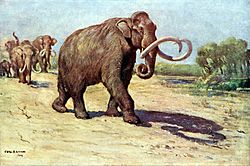 |
|
| Columbian mammoth | |
| Scientific classification | |
| Kingdom: | |
| Class: | |
| Order: | |
| Family: | |
| Genus: | |
| Binomial name | |
| Mammuthus columbi (Blumenbach, 1799)
|
|
The Columbian mammoth (Mammuthus columbi) was a species of mammoth that inhabited North America as far north as United States and as far south as Costa Rica during the Pleistocene epoch. It was one of the last in a line of mammoth species. The Columbian mammoth evolved from the steppe mammoth, which entered North America about 1.5 million years ago. Its closest extant relative is the Asian elephant. The pygmy mammoths of the Channel Islands evolved from Columbian mammoths.
Reaching 4 m (13 ft) at the shoulders, the Columbian mammoth was one of the largest species of mammoth at up to 10 tonnes (20,000 lb) in weight. It had long, curved tusks and four molars, which were replaced six times during the lifetime of an individual. It most likely used its tusks and trunk like modern elephants—for manipulating objects, fighting, and foraging.
Bones, hair, dung and stomach contents have been discovered, but no preserved carcasses are known. The Columbian mammoth preferred open areas, such as parkland landscapes, and fed on sedge, grass, and other plants. It did not live in the Arctic regions of Canada, which were instead inhabited by woolly mammoths.
The ranges of the two species may have overlapped, and genetic evidence suggests that they interbred. Several sites contain the skeletons of multiple Columbian mammoths, either as the result of single incidents such as flash floods or natural traps in which individuals accumulated over time.
Columbian mammoths coexisted with Palaeoamericans, who hunted them for food, used their bones for making tools, and depicted them in ancient art. Columbian mammoth remains have been found in association with Clovis culture artefacts; these remains may have stemmed either from hunting or from scavenging. The Columbian mammoth disappeared at the end of the Pleistocene around 11,000 years ago, most likely as a result of habitat loss caused by climate change, hunting by humans, or a combination of both.
Contents
Evolution

The earliest known members of Proboscidea, the clade that contains the elephants, existed about 55 million years ago. The closest living relatives of the Proboscidea are the sirenians (dugongs and manatees) and the hyraxes (an order of small, herbivorous mammals). The family Elephantidae existed six million years ago in Africa, and includes the living elephants and the mammoths. Among many now extinct clades, the mastodon (Mammut) is only a distant relative of the mammoths. The Asian elephant (Elephas maximus) is the closest extant relative of the mammoths.
Description
The Columbian mammoth reached 4 m (13 ft) tall at the shoulder, and it weighed up to 10 tonnes (20,000 lb, as much as 130 adult humans). It was larger than the modern African elephant and the woolly mammoth. Males were generally larger and more robust, while females were smaller and more lightly built. Like other mammoths, the Columbian mammoth had a high, single-domed head and a sloping back with a high shoulder hump. Juveniles, on the other hand, had convex backs like Asian elephants.
Dentition
Columbian mammoths had very long tusks, which were more curved than those of modern elephants. The largest known mammoth tusk belonged to a Columbian mammoth and is 4.9 metres (16 ft) long. Others range between 3.5 metres (11 ft) and 4.121 metres (13.52 ft) long. The tusks of females were much smaller and thinner. About a quarter of the length was inside the sockets. Columbian mammoth tusks were generally less twisted than those of woolly mammoths. Calves developed small milk tusks a few centimetres long at six months old, which were replaced by permanent tusks a year later. Tusk growth continued throughout life but became slower as the animal reached adulthood. The tusks grew by 2.5–15 cm (0.98–5.91 in) each year.
Natural traps
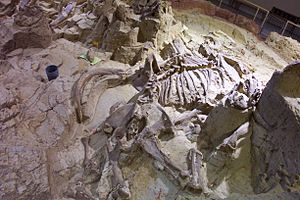
Many specimens also accumulated in "natural traps" such as sink holes and tar pits. The Hot Springs Mammoth Site in South Dakota (United States) represents a ca. 40 metre (130 ft) long sink hole that functioned for around 300 to 700 years, before it was filled with sediment. It has been determined due to OLS dating that the sinkhole at The Mammoth Site in Hot Springs, South Dakota is 140,000-190,000 years old. As of today, 58 columbian mammoths and 3 wooly mammoths have been discovered and all of them being male.
It is assumed that like modern male elephants, male mammoths mainly lived alone and were more "adventurous" (especially the young adults), therefore more likely to end up in dangerous situations than the more cautious females. The mammoths may have been lured near the hole by warm water or vegetation near the edges, then slipped in and died of drowning or starvation. Deep footprints that resulted from mammoths attempting to free themselves from the mud of the sink hole can be seen in vertically excavated sections of the site.
Diet
An adult Columbian mammoth would have needed more than 180 kg (400 lb) of food, and may have foraged as long as twenty hours every day. Mammoths chewed their food by using their powerful jaw muscles to move the mandible forwards and close the mouth, then backwards while opening, which made the sharp enamel ridges cut across each other and grind the food. The ridges were wear-resistant to enable the animal to chew large quantities of food, which often contained grit.
The trunk could be used for pulling off large grass tufts, picking buds and flowers, and tearing off leaves and branches where trees and shrubs were present. The tusks were also used for obtaining food, such as digging up plants and stripping off bark, their diet depended on the location.
Life history
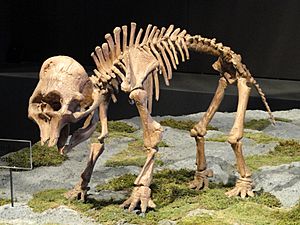
Since modern elephants have gestation periods of 21–22 months, this was possibly true for mammoths as well. The lifespan of mammals is related to their size, and since modern elephants can reach the age of 60 years, the same is thought to be true for woolly mammoths which were of a similar size. Since Columbian mammoths were even larger, they may have lived up to 80 years.
The age of a mammoth can be roughly determined by counting the growth rings of its tusks when viewed in cross section, but this does not account for their early years, as these are represented by the tips of the tusks, which are usually worn away. In the remaining part of the tusk, each major line represents a year, and weekly and daily lines can be found in between. Dark bands correspond to summers, and it is therefore possible to determine the season in which a mammoth died.
The growth of the tusks slowed when it became harder to forage, for example during disease, or when a male was banished from the herd. Mammoths continued growing past adulthood, like other elephants. Unfused limb bones show that males grew until they reached the age of 40, and females grew until they were 25.
At the age of 6–12 months, the second set of molars would be in the process of erupting, and the first set would be worn out at 18 months of age. The third set of molars lasted for ten years, and this process was repeated until the final, sixth set emerged when the animal was 30 years old. When the last set of molars was worn out, the animal would be unable to chew and feed, and it would die of starvation.
Extinction
Columbian and woolly mammoths both disappeared during the late Pleistocene and early Holocene, alongside most of the Pleistocene megafauna. The most recent Columbian mammoth remains have been dated to around 11,000 years ago. Scientists do not know whether these extinctions happened abruptly or were drawn out. During this period, 40 mammal species disappeared from North America, almost all of which weighed over 40 kg (90 lb); the extinction of the mammoths cannot be explained in isolation.
Scientists are divided over whether climate change or hunting (or a combination of the two) drove the extinction of the Columbian mammoths. According to the climate change hypothesis, warmer weather led to the shrinking of suitable habitat for Columbian mammoths, which turned from parkland to forest, grassland and semi-desert, with less diverse vegetation.
The "overkill hypothesis", on the other hand, attributes the extinction to hunting by humans. A 2002 study concluded that the archaeological record did not support the overkill hypothesis. Whatever the actual cause of extinction, large mammals are generally more vulnerable than smaller ones due to their smaller population size and low reproduction rates.
Images for kids
-
1863 lithograph of the partial holotype molar from Georgia
-
One of the largest mounted mammoth skeletons in the world, nicknamed "Archie", at Nebraska State Museum of Natural History, is the type specimen of the junior synonym Archidiskodon imperator maibeni
-
Smilodon and dire wolves fighting over a Columbian mammoth carcass in the La Brea Tar Pits, by Robert Bruce Horsfall, 1911
-
Tracings of petroglyphs from Utah, depicting two Columbian mammoths; a bison carving is superimposed on one of the mammoth carvings
See also
 In Spanish: Mammuthus columbi para niños
In Spanish: Mammuthus columbi para niños



